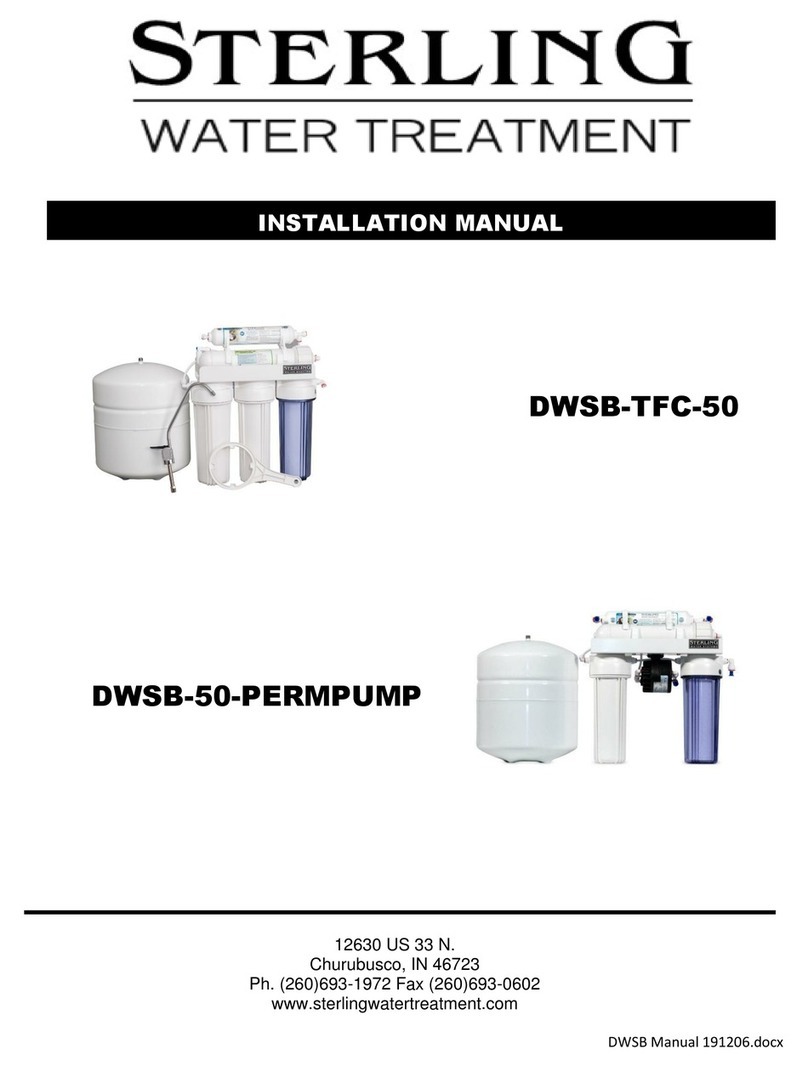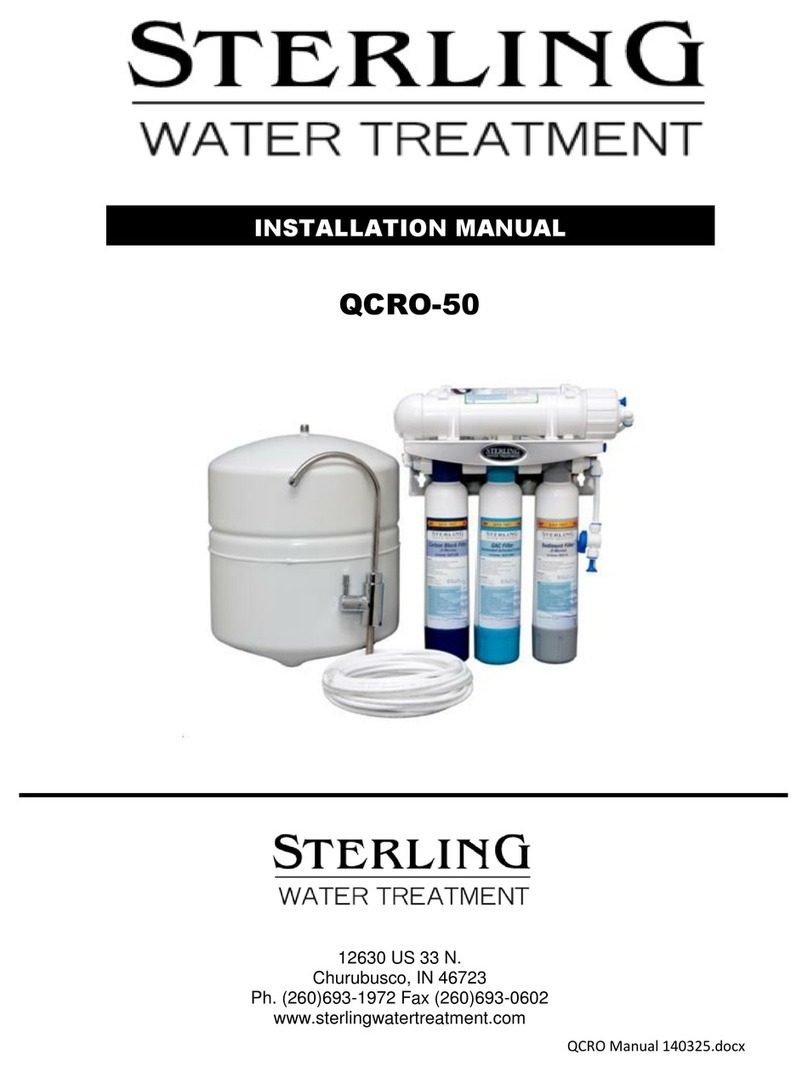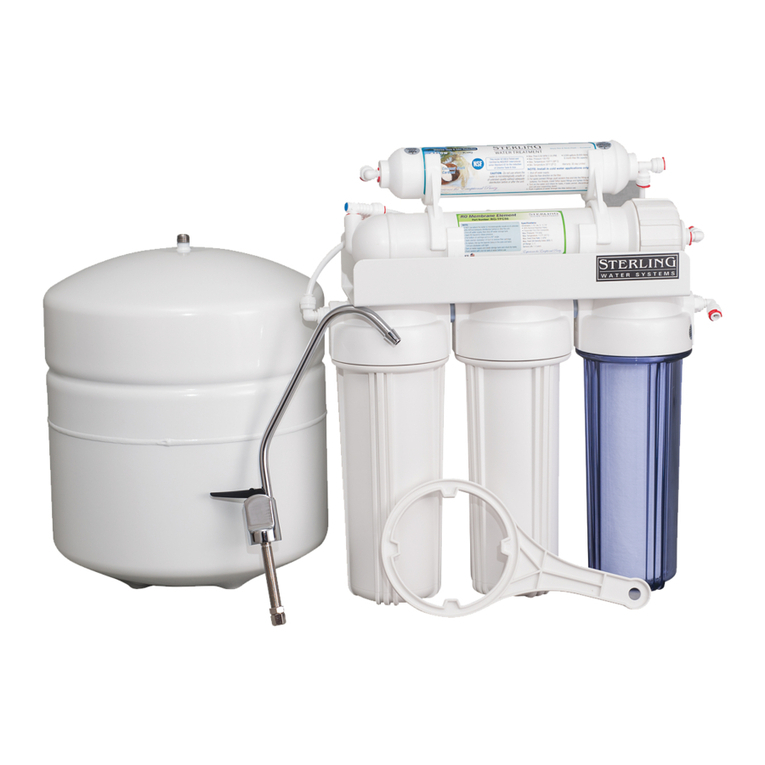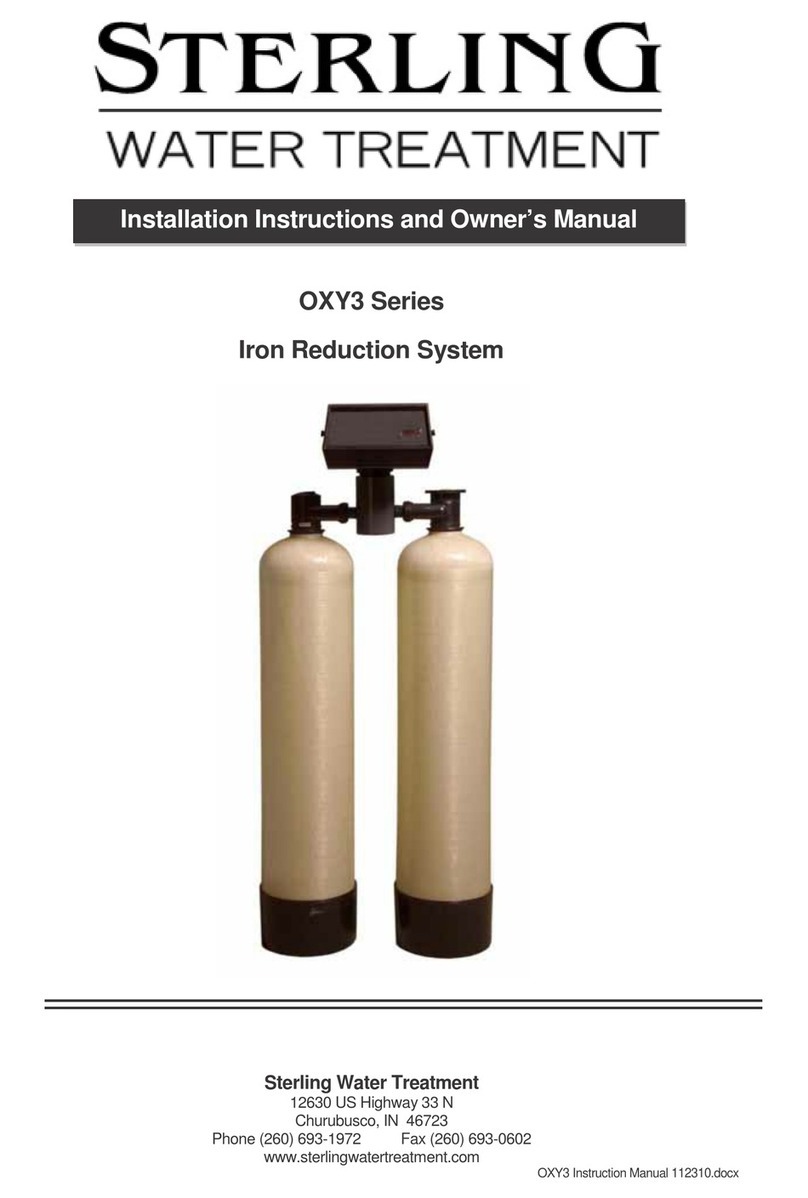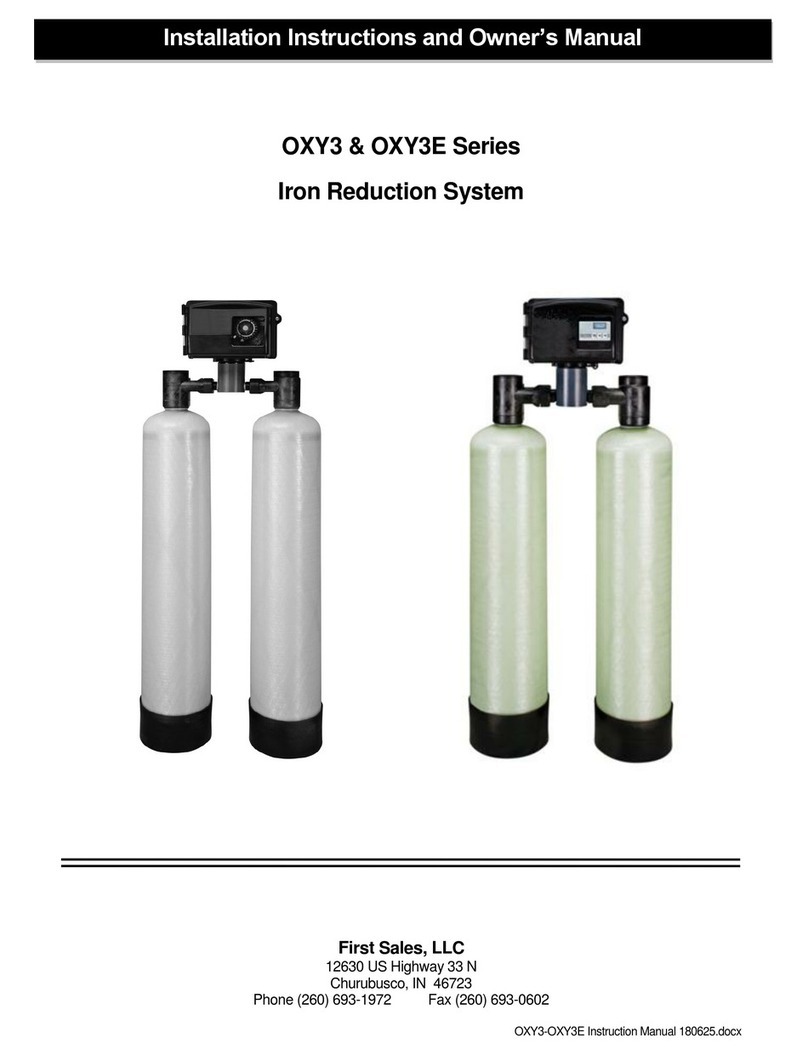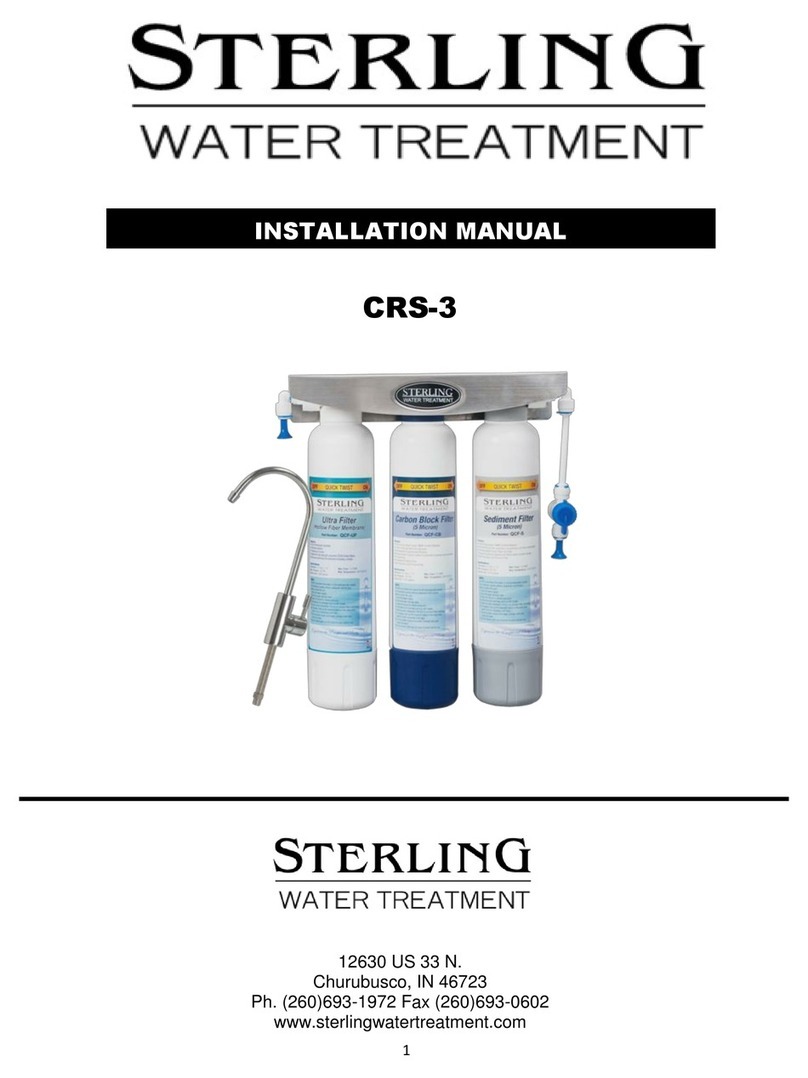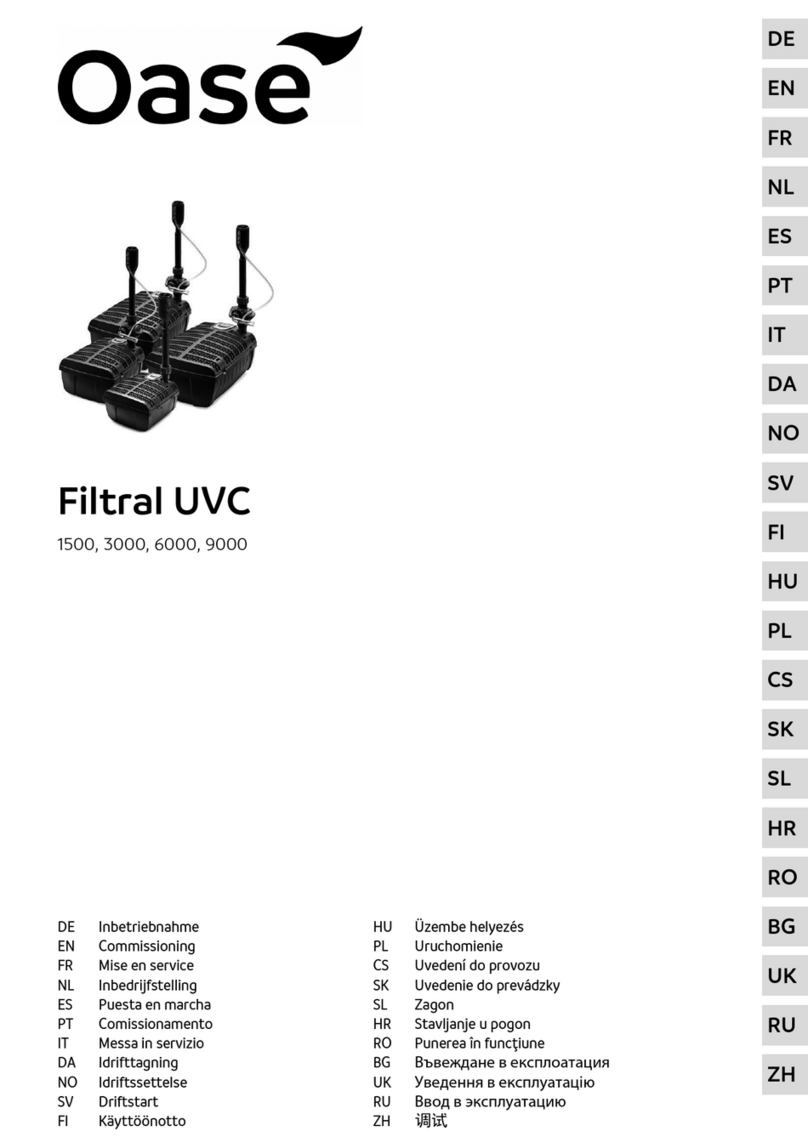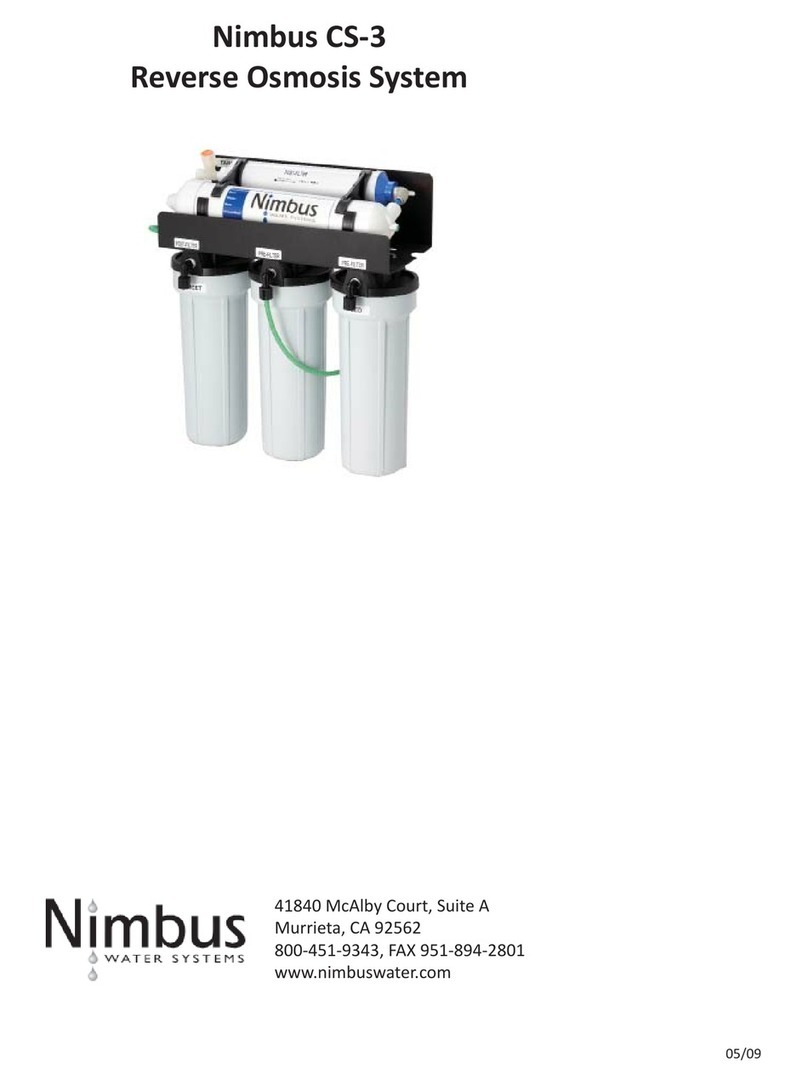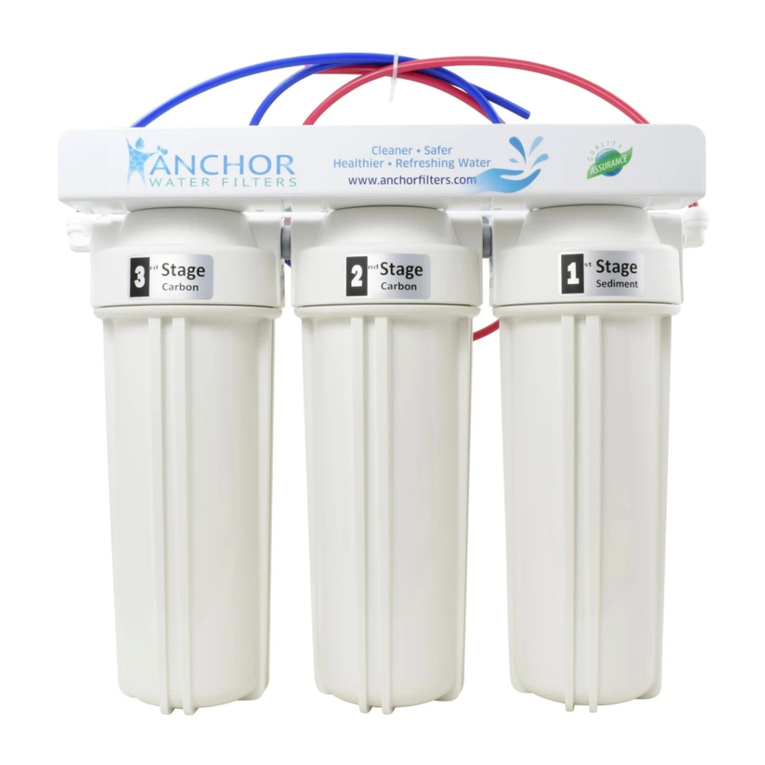Sterling QCRO-50-PUMP User manual

1
QCRO Manual 180728.docx
INSTALLATION MANUAL
12630 US 33 N.
Churubusco, IN 46723
Ph. (260)693-1972 Fax (260)693-0602
www.sterlingwatertreatment.com
QCRO-50
QCRO-50-PUMP
SRO-100

2
SECTION I. INTRODUCTION.......................................................................3
SECTION II. SPECIFICATIONS....................................................................4
SECTION III: PREPARATION........................................................................5
A. Major System Components.................................................................................................5
B. Tools Recommended for Installation...................................................................................5
C. Determine System Location................................................................................................5
D. Prepare the Area for Installation..........................................................................................6
E. Prepare the Appliance for Installation..................................................................................6
SECTION IV. INSTALLATION STEPS...........................................................7
A. Install the Faucet..................................................................................................................7
1. Make the Faucet Mounting Hole...............................................................................7
2. Mount the Faucet......................................................................................................8
B. Install the Feed Water Valve and Tubing...........................................................................8
C. Prefill and Sanitize the Storage Tank..................................................................................9
D. Install the Drain Connection................................................................................................9
E. Install the RO Membrane...................................................................................................10
F. Make Initial Tubing Connections........................................................................................10
G. Install the R.O. Assembly and Storage Assembly..............................................................10
H. Make Final Tubing Connections.........................................................................................10
I. Install Ice Maker Hookup (optional)....................................................................................10
J. Start up the System.............................................................................................................11
K. Flush System of Preservative and Check Operation..........................................................11
SECTION V: OPERATION & MAINTENANCE..................................................12
A. Normal Operation...............................................................................................................12
B. Changing Filters.................................................................................................................12
C. For Systems Equipped with Quick Connect Fittings..........................................................13
SECTION VI: TROUBLESHOOTING GUIDE.....................................................14
QCRO-50 PARTS BREAKDOWN.......................................................................16
QCRO-50-PUMP PARTS BREAKDOWN...........................................................18
SRO-100 PARTS BREAKDOWN……………………………………………………20
LEAK STOP VALVE –Compressed Pellet Replacement................................22
WARRANTY…………………………………….………..........................................23
TABLE OF CONTENTS:

3
QCRO Manual 180728.docx
SECTION I. INTRODUCTION
Congratulations, you have just purchased one of
the finest reverse osmosis drinking water
appliances available.
Like any other fine product, this appliance requires
periodic maintenance in accordance with the
schedule outlined below.
Your new Reverse Osmosis (R.O.) drinking water
system uses a combination of filtration technologies
to reduce unwanted contaminants in a water
supply. The following steps combine to give you the
best quality drinking water:
MECHANICAL FILTRATION - The sediment pre-
filter will remove the larger particles such as silt,
rust and scale. Its 5 micron (equal to 0.0002 inch)
nominal rating helps to give maximum life to the
R.O. membrane and carbon filter.
ACTIVATED CARBON PRE FILTERS - The first
carbon filter contains granular activated carbon
which removes chlorine and absorbs organics that
can damage the membrane. The second carbon
filter is a carbon block that has activated carbon
with a smaller pore size to increase the range of
organics removed and extend the amount of
chlorine reduction. Carbon block filter has a five
micron rating to further protect the membrane.
REVERSE OSMOSIS MEMBRANE -The R.O.
membrane is the heart of the filtration system. It is
designed to reduce the dissolved mineral content of
the water. Minerals picked up in the environment by
the water are measured as Total Dissolved Solids
(T.D.S.).In the reverse osmosis process, dissolved
minerals are separated from the incoming water
(feed water) to produce the product water
(permeate). The excess minerals are rinsed to
drain (reject water). The spiral wound construction
of the R.O. membrane provides maximum surface
area for water production and is less susceptible to
fouling by particulate matter, turbidity and colloidal
materials.
ACTIVATED CARBON POST FILTER - The Inline
carbon post filter cartridge contains carbon particles
with a vast network of pores. The tremendous
surface area of these pores (typically 800-1200
square meters per gram of carbon) gives the
carbon very good adsorptive sites for chlorine as
well as other substances that contribute to tastes
and odors. The product water from the membrane
as well as the holding tank passes through the
activated carbon post-filter on the way to the
dispensing faucet. The activated carbon post filter
reduces tastes and odors that may pass through
the system. It adds a final “polish” to the water.
Recommended Filter Change Schedule*
1 - Pre-filter, 10”, 5 Micron 6 Months
2 - Granulated Activated 6 Months
Carbon Pre-Filter
3 - Carbon Block Pre-filter 6 Months
4 - Reverse Osmosis 24-36 Months
Membrane
5 - Inline Carbon Post Filter 6 Months
*Based on standard conditions

4
SECTION II. SPECIFICATIONS
TABLE A –QUALIFIED SYSTEM PERFORMANCE
Because the performance of an R.O. membrane is highly dependent upon pressure, temperature and TDS, the
following should be used for comparison purposes only.
U.S. Metric
Membrane Production140-60 gpd 151-227 Ipd
Membrane TDS Reduction193% minimum 93% minimum
Drain (reject water) Flow 3-5 x product flow 3-5 x product flow
Empty Storage Tank Precharge 5-7 psig air 35-48 kPa air
1Industry standards measure R.O. membranes performance with no backpressure on the product water, at 65 psig
(448kPa) and 77°F (25°C), and 600 ppm TDS. Production rate and TDS reduction figures are for a new membrane that
has been rinsed for 24 hours. The production rate of a new membrane can decrease by 10% per year or more, depending
upon the scaling and fouling tendencies of the feed water. Actual production is typically 50% of the membrane rating, and
TDS reduction level 75% or better depending upon the supply water quality, pH, temperature & pressure.
TABLE B –RECOMMENDED OPERATING LIMITS FOR FEED WATER
Specifications T.F.C. Membrane
Water Pressure 40-100 psig (280-690 kPa)
TDS 800/1,800 ppm (also mg/l) max (non-pump/pump model)
Temperature 40-100°F (4-38°C)
pH 4-11 (optimum rejection at pH 7.0 –7.5)
Hardness Less than 7 gpg (120 mg/l) or soften (recommended)
Iron Less than 0.1 ppm (also mg/l)
Manganese Less than 0.05 ppm (also mg/l)
Hydrogen Sulfide None
Chlorine See note
Bacteria Must be potable**
NOTE: Chlorine will damage a T.F.C. Membrane. The activated carbon pre-filters have been designed to reduce chlorine from
the incoming water. Change filters every 6 months, more often if the water contains more than 1 ppm chlorine.
**DO NOT USE WITH WATER THAT IS MICROBIOLOGICALLY UNSAFE OR OF UNKNOWN QUALITY.

5
SECTION III: PREPARATION
A. Major System Components
The following components comprise the R.O. drink-
ing water system:
1) A reverse osmosis assembly consisting of the
aluminum bracket, filter housings, automatic
shut-off, membrane module and an in-line
carbon filter. Approx. 17”H x 13”W x 5”D
2) A drinking water storage tank. Approximate
dimensions (with base and ball valve):
16”H x 11” Diameter.
3. A faucet kit.
4. A plastic tubing kit with self-piercing saddle valve
and drain clamp.
5. Other items necessary for installation may
include wood screws or machine screws for
mounting the R.O. assembly concrete anchors
may be required for hanging on basement wall,
additional tubing or tube connectors, and plastic
wire ties for organizing tubing.
B. Tools Recommended for Installation
The following tools will cover most of the installation
sites encountered:
3/8" variable speed electric drill.
Extension work light with outlet.
Safety Glasses.
1-1/4" porcelain hole cutter kit.
1-1/4" Greenlee hole punch and 1/8" and
1/2"metal drill bits for pilot hole.
Center punch and hammer.
1-1/4" wood bit.
Assorted wood and metal drill bits including
7/32" metal drill bit.
Phillips head and flat blade screwdrivers.
1/2", 9/16" and 5/8" open end wrench.
10" Crescent wrench with jaws taped to
hold faucet.
Teflon tape.
Wide masking tape or duct tape.
Plastic tubing cutter.
Extra plastic tubing.
Low range air pressure gauge.
Bicycle hand air pump.
Small bottle of liquid chlorine bleach.
C. Determine System Location
The R.O. system can be located under a sink or in
a basement depending on space availability and
the customer’s preference.
If a basement installation is selected, additional
tubing, hardware and fittings may be needed and a
hole will have to be made from inside the cabinet,
through the floor, to the basement. Never install in
an area of the home where temperature is freezing
as damage to the system will result.
Considerations for an ice maker or other remote
hook up should be determined, including routing
and any additional tools, fittings, and tubing that
may be required.
CAUTION: If the system is installed where a leak
may result in serious damage, a leak stop valve
must be installed. (part number: RO-LSV)
1) Faucet - The faucet should be placed near
the sink where drinking water is normally
obtained. Convenience of use (filling of
water pitchers and glasses), and an open
area beneath the faucet under the sink for
attaching product tubing are considerations.
A 2" diameter flat surface is required above
and below the mounting site. The thickness
of the mounting surface should not exceed
1-1/4".Watch for strengthening webbing on
the underside of cast iron sinks.
2) Drinking Water Storage Tank - The storage
tank may be placed anywhere within 10 feet
of the faucet. Under the sink or in an
adjacent cabinet are best choices. If a
longer run of tubing is required, the tubing
should be 1/2" diameter O.D. size to pre-
vent a high pressure drop. Remember,
these tanks can weigh up to 30 pounds
when full of water, a firm, and level area is
required.
3) R.O Assembly - The R.O. assembly may be
mounted anywhere under the sink area or a
cabinet. Mounting in the basement is also
an option, one possible location is near the
laundry /utility sink where cold potable water
and drain access is handy. The mounting
location should allow adequate clearance
and accessibility for cartridge changes.

6
4) Feed Water Connection - The self-piercing
feed water shut off valve should be located
as close to the R.O. assembly as possible.
USE A POTABLE COLD WATER SUPPLY
ONLY. Softened water is preferred as it will
extend the life of the R.O. membrane.
5) Drain Connection - The drain saddle
assembly is designed to fit around a
standard 1-1/2" OD drain pipe. The drain
saddle should always be installed above
(before) the trap and on the vertical or
horizontal tail piece. Never install the drain
saddle close to the outlet of a garbage
disposal or plugging of the RO drain line
may occur. If discharging into an utility sink
or standpipe, an air gap of greater than 1"
above the flood rim must be provided. Do
NOT connect the system drain line to the
dishwasher drain or near the garbage
disposal.
6) Leak Stop Valve –RO systems inherently
have many connections which could leak. It
is absolutely necessary to install the
included Leak Stop Valve very close to
and/or under the RO assembly. It must be
fastened to the floor or cabinet base with
screws or double-sided tape. The feed
water supply must pass through the Leak
Stop Valve. Should a leak occur and the
underside of the Leak Stop Valve gets
moist, the feed water will be terminated.
Once activated, the Leak Stop Valve can be
reset one time.
D. Prepare the Area for Installation
To save time it is often advised to call the customer
and request they clear under the sink prior to
arrival. Otherwise, remove supplies from under the
sink and stack them neatly away from the working
area. Arrange a light for the work area, if
necessary.
If a basement installation is called for, determine
where components will be located and how they will
be mounted. Special mounting brackets and
hardware may be necessary to secure the system
to a wall or ceiling joists.
Inspect cold water supply line and drain to
determine if any special fittings, in addition to what
is included in the kit, are required.
E. Prepare the Appliance for Installation
Open shipping carton and remove components.
Check that all installation parts are present which
includes the R. O. assembly, storage tank, faucet,
installation hardware, and tubing.
Check that the air supply in the empty tank is
approximately 7 psi. Adjust if necessary.

7
SECTION IV. INSTALLATION STEPS
All plumbing should be done in accordance with
state and local plumbing codes.
NOTE: Some codes may require installation by a
licensed plumber; check with the local plumbing
authority prior to installation.
In restricted under-sink areas, it may be easier to
install the faucet first. Allow adequate tubing
lengths for any final component position.
A. Install the Faucet
See Figure 1 for Faucet Installation Diagram
The customer should be consulted before
determining faucet location. The faucet should be
positioned so that it empties into the sink and the
spout swivels freely for convenience.
If the sink already has a hole provided that can
accommodate the RO faucet, then no drilling is
required and you can proceed to the section on
mounting the faucet.
1. Make the Faucet Mounting Hole
IMPORTANT: It is mandatory that safety glasses
be worn during sink hole drilling operations to
prevent eye injury.
Before starting the hole making operation, always
check below the sink so that nothing interferes with
mounting the faucet such as reinforcing ribs,
support brackets or cabinet construction.
STAINLESS STEEL SINK:
Recommended tools:
Center punch
Variable speed drill and high speed drill bits.
Greenlee chassis punch 7/8” hole size
(alternate 9/16” size may be used for non air
gap faucet)
Protective gloves
Procedure:
a) Center punch a small indent at the desired
faucet location.
b) Slowly drill the required pilot hole for the
chassis punch.
c) Set up the chassis punch per instructions
and tighten nut to cut the desired hole
size.
d) Clean up sharp edges with a file if
necessary.
PORCELAIN/ENAMEL/CERAMIC ON SHEET
METAL OR CAST IRON BASE:
Recommended tools:
Variable speed drill
Relton porcelain cutter tool set 7/8" size
(alternate 9/16: size may be used for non-air
gap faucet)
Plumber’s putty
It is important to understand what is involved in this
procedure. First, the glassy layer of porcelain must
be penetrated through to the base metal. Second, a
center disc of porcelain must be removed while
protecting the surrounding porcelain against chip
ping or fracturing. Third, the base metal must be
drilled through to complete the hole.
Procedure:
a) Mark the center for the 7/8” hole
b) Form shallow putty dam around hole area
and fill with enough water to lubricate
carbide drill bit.
c) Carefully drill plot hole through
porcelain/enamel and base metal using
carbide type pilot drill.
IMPORTANT: Always operate drill with light
pressure at slow speed (300-400 rpm).
d) Insert pilot tip of spring-loaded porcelain
cutter into pilot hole.
e) Drill porcelain/enamel using spring-loaded
porcelain cutter, making certain a complete
ring has been cut through the
porcelain/enamel to the metal base.
f) Change to the metal cutter. With slow
speed and light pressure, cut away the inner
porcelain/enamel disc down to base metal.
Make certain that the cutter does not touch
outer rim of the cut porcelain/enamel.
Continue with this bit to cut through metal
until sink has been completely penetrated.
IMPORTANT: When using a porcelain
cutter it is critical to take precautions that it
is always in a sharpened condition. Dull
cutters are known to chip sinks.

8
2. Mount the Faucet:
a) Familiarize yourself with all components
shown in faucet diagram.
b) Remove the compression nut, plastic ferrule
and hex nut from the threaded nipple and
assemble the o-ring, chrome base plate and
rubber washer onto the nipple.
NOTE: Rubber washer may be replaced
with bead of plumber’s putty for neater
appearance.
c) Feed the threaded nipple through
sink/counter mounting hole and orient the
faucet as discussed with the customer.
d) From below sink/counter assemble the large
metal washer, star washer and hex nut on
threaded nipple and tighten by hand.
e) After rechecking faucet orientation, tighten
hex nut (9/16" wrench or deep socket) until
faucet feels secure.
f) From above the sink make any minor
orientation corrections by turning the faucet
with a padded adjustable wrench.
Note: Flats on chrome faucet may be used
for tightening with an adjustable wrench.
Use care not to mar chrome finish.
g) Connect a length of standard 3/8" tubing to
faucet. If using the standard compression
fitting, ensure the plastic insert is in the end
of the tubing. Feed the compression nut and
plastic ferrule onto the tubing. Push the
tubing and insert through the opening in the
threaded nipple until it seats. Thread the
compression nut onto the nipple and tighten
securely. If using the quick connect faucet
fitting (6FC4) instead, discard the
compression nut, plastic ferrule and tube
insert. Thread the quick connect fitting
securely onto the threaded nipple and firmly
insert the 3/8" tubing into the quick connect
fitting.
B. Install the Feed Water Valve and Tubing
The saddle tapping valve supplied is designed for
use with 3/8" to 1/2" OD soft copper supply tubing
(plain or chromed), rigid metal pipe, or CPVC
plastic pipe. Do not use with flexible ribbed supply
tubing which has too thin a wall thickness and
requires special hardware.
Saddle Valve Installation
SOFT COPPER TUBING INSTALLATION:
1) Turn off cold water valve under the sink, or
main valve for the house.
2) Before installing saddle tapping valve, make
sure piercing lance does not protrude
beyond rubber gasket.
3) Assemble saddle tapping valve on copper
tubing. Tighten clamp.
4) To pierce soft copper tube, turn handle
clockwise until it is firmly seated. The valve
is closed in this position.
5) Turn on main supply valve to pressurize
coldwater line. Check for leaks. With a
wrench, snug nut/seal around valve stem.
6) Connect one end of the tubing to the feed
water valve using brass compression nut
and plastic sleeve.
NOTE: For basement installations the
existing feed water tubing may have to be
longer to reach feed valve.

9
RIGID METAL PIPE AND CPVC PLASTIC PIPE
INSTALLATION:
1) Turn off cold water supply valve and drain the
line to prevent spillage.
2) Drill 3/16" hole at the desired location. To pre-
vent shock hazard, use a battery operated drill.
3) Before installing saddle tapping valve, make
sure piercing lance does not protrude beyond
rubber gasket.
4) Assemble saddle tapping valve on copper
tubing.
5) Turn saddle valve handle clockwise to close
valve. With a wrench tighten nut/seal around
valve stem.
6) When you wish to open valve and supply cold
water to the unit, turn valve handle counter
clock wise.
7) Connect one end of the tubing to the feed
water valve using brass compression nut and
plastic sleeve.
NOTE: For basement installations the existing
feed water tubing may have to be longer to
reach feed valve.
C. Pre-fill and Sanitize the Storage Tank
Pre-filling the tank is always recommended so there
is pressure to check for leaks and several gallons
of water to flush carbon post filter. Tanks are
furnished with a special disinfectant and only
require filling with water and 15 minutes of contact
time to be completely sanitized. It is important to
use a sanitizer when pre-filling tank so the solution
can sanitize the tubing, fittings, and faucet at the
time of installation and startup.
1) Insert free end of feed water tubing into the
fitting on the storage tank.
2) Open feed water valve and tank valve and
allow tank to fill (about 3 minutes).
3) Turn off feed water valve, tank valve, remove
tank from tubing and set tank aside (15
minutes minimum).
D. Install the Drain Connection
IMPORTANT: Before starting this procedure,
inspect the condition of the drain piping, especially
in older homes where the traps and tailpieces can
be deceptively thin and frail. If in poor condition, it is
wise to inform the customer that the condition
should be remedied.
The drain saddle assembly is designed to fit around
a standard 1-1/2" OD drain pipe.
The drain saddle should always be installed above
(before) the trap and on the vertical or horizontal
tail piece. Never install the drain saddle close to the
outlet of a garbage disposal or plugging of the RO
drain line may occur.
1) Peel adhesive covering from the back of foam
square gasket and line up with the hole in the
saddle drain and apply. This gasket provides
a leak proof seal on the drain stand pipe.
2) Position both halves of drain saddle at
desired location on drain pipe.
3) Use bolts and nuts to clamp drain saddle onto
drain pipe. Do not over tighten and make sure
there is equal space between saddle halves
on each side.
4) Carefully drill hole through threaded fitting of
drain saddle (as shown in Photo 2) being
careful not to drill through opposite side of
drain pipe.
5) Insert drain tubing into compression nut and
tighten onto drain saddle.

10
E. Install the R.O. Membrane
Disconnect the tubing from the end cap of the
membrane housing. Then, unscrew the end cap
from the membrane housing. Insert the membrane
as illustrated below. The o-rings on the product
water tube of the membrane MUST BE FULLY
SEATED in the membrane housing for proper
operation. Also make sure that the brine seal on the
membrane seals with no gaps or wrinkles inside the
membrane housing. Once the membrane is
installed, replace the end cap and reconnect the
tubing.
The RO membrane contains a special preservative.
To insure that all the preservative is flushed from
the system before use, DO NOT use the first two
tankfuls of water produced by the system.
F. Make Initial Tubing Connections
It is advantageous to make some of the tubing
connections at this time, since the under-sink work
area is not so crowded and access to the
components is easier.
G. Install the R.O. and Storage Assemblies
The R.O. assembly is usually mounted to the right
or left sink cabinet sidewall, taking into con-
sideration the space available and the tank
location. Generally, the tank is placed in the rear of
the cabinet while the R.O. assembly is positioned
toward the front for cartridge accessibility.
To mount the R.O. assembly elevate at least 2" off
the cabinet floor and, while keeping level, mark the
location of the mounting holes on cabinet sidewall.
Make small pilot holes with an awl or drill and screw
in the two mounting screws, leaving just enough
protruding to allow bracket mounting slots to slide
over them.
NOTE: If the cabinet sidewalls are not of solid
construction, the purification assembly can be set
on the cabinet floor and held against the sidewall
with the mounting screws.
The tank may be oriented either vertically or
horizontally. It is generally placed to the rear of the
cabinet but can be set in the front center (between
the sink basins) for ease of access if space permits.
H. Make Final Tubing Connections
With all of the components in place, the final tubing
connections can be made. When routing tubing
between components, several guidelines should be
observed.
Tubing runs should generally follow the con-
tour of the cabinets rather than interfere with
the cabinet storage area.
Strive for neatness and an orderly tubing
“flow” using fasteners (e.g. insulated
staples) to secure the tubing. Cut tubing to
the desired length.
Arrange the tubing so there are no sharp
bends and leave some “play” in the tubing
for ease of servicing.
Try to keep the tubing from the R.O.
assembly to the tank and faucet as short as
practical for good flow.
Be sure to install the Leak Stop Valve in the
feed water line next to, or under the RO
assembly. Note the arrow on the Leak Stop
Valve indicating the direction of flow.
Secure the valve with screws or double-
sided tape.
I. Install Ice Maker Hookup (optional)
Note: Check with refrigerator or icemaker
manufacturer for compatibility with your refrigerator
model. Some icemakers require higher line
pressure to operate properly; a pump model
(QCRO-50-PUMP or SRO-100) may be required.
Hooking up an ice maker involves connecting a tee
with shut off valve into the faucet tubing and routing
tubing over to the refrigerator. Do not hookup to
existing copper tubing.
Before turning off the existing tap water supply to a
refrigerator ice maker, always shut off the ice
maker first (usually by lifting the lever arm above
the bin to the upper most position). The ice maker
should only be turned on again after the R.O.
system has been drained several times and the
tank has a full supply of water.

11
NOTE: Before any service is performed on the R.O.
system, always turn off ice maker valve and the ice
maker unit. Only turn on when system is operating
and tank is full.
J. Start up the System
1) Double check that all connections are
secure.
2) Open the feed water valve and check for
leaks. If any leaks are noted, turn off valve
and correct before proceeding.
3) Open the storage tank valve and open the
faucet until a steady stream of water flows.
Close faucet, wait at least 5 minutes and
carefully check for leaks. Correct as
necessary.
K. Flush System of Preservative and Check
Operation
1) Lift faucet handle and allow tank to drain
completely of sanitizing solution. DO NOT
USE THIS WATER. When tank is empty,
the faucet will steadily drip. This is the rate
water is produced by the RO system.
2) With faucet handle in “up” position, measure
the rate of the steady drip from spout. Use a
graduated cylinder (in milliliters) and watch
with a second hand to calculate
approximate production in gallons per day
(milliliters per minute X 0.38 = gpd).
Proceed to check reject flow rate by
disconnecting tubing at drain connection
and measure as per above. The ratio
should be a minimum of 2.5 (reject) to 1
(product).
3) Close faucet and re-inspect system for
leaks. Instruct customer to wait at least 4
hours and drain tank again. The water
should be discarded as it may contain some
preservative/disinfectant chemicals.
4) System should be ready to use as soon as
the tank refills. If any objectionable taste is
noticed after second tank draining, instruct
customer to wait and drain tank the
following day.
5) The accessory pack contains a tee fitting to
connect a refrigerator water dispenser or ice
maker, if desired. Prior to connecting
additional devices to this reverse osmosis
system refer to manufacturer’s
recommendations to ensure that water
quality and pressure are within the
recommended limitations. If one is
connected to the system, an ice maker
should be turned on only AFTER the
flushing procedure.
NOTE: All factory assembled components were
pressure tested for leaks. Prior to
leaving the unit unattended,
check all fittings and tubing
connections for leaks. The
accessory pack contains
replacement o-rings for the
membrane housing and quick
change filters, as well as a
replacement swivel connector, if
needed.
See page 13 to correct leaks at
tubing connections.

12
SECTION V.
OPERATION & MAINTENANCE
A. Normal Operation
1) It is normal for the Total Dissolved Solids
(T.D.S.) of the water to be elevated during
the first 5 gallons of operation; this is due to
the sanitizing solution and the new post
filter. After this water is rinsed to drain, the
removal rate should stabilize at a value
greater than 75%. Water pressure affects
the production rate and quality.
2) R.O. systems produce drinking water at
relatively slow rates; it can take up to 8
hours or more to fill the storage tank.
Normal operation is to let the storage tank
fill with water and then draw water as is
needed. When the pressure in the storage
tank falls to a given pressure (as the water
is being used) the automatic shut-off valve
(A.S.O. valve) will start water production
and the system will refill the storage tank.
When the storage tank is full and no water
is being used, the A.S.O. valve will
automatically shut off the feed water to
conserve water.
The more water that is used (up to the capacity of
the system) the better the R.O. system will function.
After periods of non-use, such as a vacation, it is
better to empty the holding tank and allow the
system to produce fresh water for use. If the
system is not used for 3-4 weeks or longer, it is a
good idea to re-sanitize the system and to change
the activated carbon and sediment filters.
B. Changing Filter & Sanitizing the system
NOTE: THIS R.O. SYSTEM CONTAINS FILTERS
WHICH MUST BE REPLACED AT REGULAR
INTERVALS TO MAINTAIN PROPER
PERFORMANCE. USE ONLY FACTORY
APPROVED FILTERS.
Please see Page 3 for the recommended interval
for changing the filters. Local conditions may
dictate more frequent changes.
Use a drip pan to catch any water that may spill
when the filter housings are removed:
1) Close plastic supply valve located on the
inlet line of the system.
2) Close the valve on the inlet of the storage
tank.
3) Open the faucet and wait for the flow to
stop.
4) The pre-membrane cartridges can be
hinged out away from the wall. Rotate the
cartridge 1/4 turn counter clockwise and pull
down. The cartridges can be disposed.
5) Push the new filter into the head and rotate
it clockwise ¼ turn.
6) Wipe up any spilled water.
7) To change the in-line post filter refer to the
section dealing with quick connect fittings.
C. Quick Connect Fittings
Your new reverse osmosis drinking water appliance
is outfitted with new generation of user-friendly
quick connect push-in fittings. Proper use of the
fittings is shown in the diagrams.
It is important that the tubing selected for use with
these connectors be of high quality exact size and
roundness, and with no surface nicks or scratches.
If it is necessary to cut the tubing, use a plastic
tubing cutter or sharp razor knife. Make a clean,
square cut.
An optional blue locking clip is installed in certain
fittings to provide extra security. Remove this clip
first before trying to remove tubing by sliding away
from fitting.
Should a leak occur at a fitting, the cause is usually
defective tubing. See next page for instructions on
fixing a leak from a quick connect fitting.

13
To fix a leak:
Relieve pressure
Release tubing
Cut off at least ¼” from end
Reattach tubing
Confirm connection is leak free
TO ATTACH TUBING...
TO RELEASE TUBING...

14
QCRO Manual 180728.docx
SECTION VI. TROUBLE SHOOTING GUIDE
Problem
Possible Cause
Solution
Low quantity of Product
Water from Storage Tank
Feed water saddle valve is
plugged or closed.
Open valve or unclog.
Clogged sediment pre-filter or
activated carbon pre-filter.
Replace filters.
Low water pressure
Feed water pressure must be above
40 psig.
R.O. membrane is fouled.
See feed water operating limits
(page 4). Correct cause of fouling,
replace membrane.
Plugged activated carbon post
filter.
Replace post-filter.
Air pre-charge pressure in storage
tank is too high.
Empty water from storage tank, and
with the faucet open, adjust air
pressure to 5–7 psig (5–8k Pa)
range.
Air pre-charge is too low.
See above and check for leakage at
the air valve stem.
Air bladder in the Holding Tank is
ruptured.
Replace tank.
Holding Tank Valve is closed.
Open valve.
No drain flow, the Drain Restrictor
or drain line is plugged.
Clear or replace drain restrictor
and/or drain line.
The Check Valve is stuck.
Clear or replace check valve.
The ASO valve (Auto Shutoff
valve) is malfunctioning.
Replace ASO valve.
Low pressure at the
Dispensing Faucet
Air pre-charge in the storage tank
is too low.
Empty water from storage tank and
with the faucet open, adjust the air
pressure to 5–7 psig (5–8 kPa)
range. Check for leakage at the air
valve stem.
Storage tank valve is partially
closed.
Open valve.
The dispensing faucet is out of
adjustment or faulty.
Repair or replace dispensing faucet.
Heavy water use, storage tank is
depleted.
Allow storage tank to refill (adding a
second storage tank will increase
storage capacity).
Low water production.
See “Low Quantity of Product Water
from Storage Tank”section above
Clogged sediment pre-filter or
activated carbon pre-filter.
Replace filters.
Low water pressure
Feed water pressure must be above
40 psig.

15
Problem
Possible Cause
Solution
High Total Dissolved
Solids (TDS) in the
Product Water
Low water pressure.
Feed water pressure must be above
40 psig.
R.O. membrane is not fully seated
in the bottom of the housing.
Re-seat the R.O. membrane.
R.O. membrane o–rings are
damaged or missing.
Check o–rings.
R.O. membrane brine seal is not
sealing properly.
Check the brine seal.
R.O. membrane is expended.
Replace membrane. Check
operating limits (page 4).
The Product water and drain water
lines are reversed.
Correct plumbing.
The ASO valve (Auto Shutoff
valve) is allowing drain water to
mix with product water.
Replace ASO valve.
No drain flow, drain restrictor is
clogged.
Clear or replace drain restrictor.
No drain flow, the drain orifice in
the dispensing faucet (optional air
gap faucet only) is plugged.
Clear or replace dispensing faucet.
The ASO valve (Auto Shutoff
valve) is not closing.
Replace the ASO valve.
New post-filter or activated carbon
pre-filter not rinsed completely.
Flush with two full tanks of product
water.
The feed water TDS has
increased.
An increase in feed water TDS will
give a corresponding increase in
product water TDS.
Tastes and odors in the
Product Water
The post-filter or activated carbon
pre-filter is exhausted.
Replace filters.
There is foreign matter or bacteria
in the R.O. system.
Clean, flush and sanitize the
system. Replace the filters.
The product water and drain water
lines are reversed.
Correct plumbing.
Dissolved gasses in the feed
water.
Pre-treat feed water to remove
dissolved gasses.
Increase in product water TDS.
See “High TDS in the Product
Water”section.
Faucet leaks or drips
Leaks from base of the delivery
tube.
O–ring is bad, replace o–ring.
Fitting leaks in general
Close the feed water saddle valve and relieve pressure before
disconnecting any tubing or replacing any fitting. Before replacing a
fitting, re–cut the tubing and re–insert into the fitting to see if that solves
the leak. If pipe threads are leaking, remove and re-tape with Teflon®
tape.

16
1
2
4
5
6
7
8
9
10
DRAIN
SUPPLY
11
12
13
3
3
3
14
3
15
16
17
18
QCRO-50 Component Parts Breakdown
19
20
14
21
3a

17
REF #
Part Number
Description
1
RO-DW-1
Luxury Long Reach Faucet, Non Air Gap, Chrome
2
6FC4
Faucet Connector, 3/8" tube x 7/16 UNF thread
3
4SE4
Stem Elbow, 1/4" tube x 1/4" stem
3a
6SE4
Stem Elbow, 3/8” tube x 1/4” stem
4
IC10Q
2" x 10" Inline Filter, GAC, 1/4" Quick Connect
5
6SE4/4SST4
Side Stem Tee, 3/8" tube x 1/4" stem x 1/4" tube
6
ADS-1Q
Auto Drain Shut-Off Valve
7
BV-103
Ball Valve, 3/8" QC x 1/4" FNPT
8
SRO-ST2
RO-3 Storage Tank, Steel, 3.2 Gallon Capacity
9
RO-FR14
1/4" QC Flow Restrictor 350 ML
10
SC500B-14
Drain Saddle, 1/4"
11
1000201
Membrane Housing with Cap, Universal, (less membrane)
12
RO-TFC50
Universal R.O. Membrane, 50 GPD
13
RO-CVQC
Check Valve for RO System, Quick Connect
14
4MC
Male Connector, 1/4" tube x 1/4" NPT
15
F-SAD
Supply Saddle Valve, 1/4" Thread
16
QCF-S
Quick-Change Filter, Sediment
17
QCF-GAC
Quick-Change Filter, Granular Activated Carbon
18
QCF-CB
Quick-Change Filter, Carbon Block
19
BV-101
Ball Valve, 1/4" tube x 1/4" tube
20
RO-HOR
O-Ring for Membrane Housing
21
RO-LSV
Leak Stop Valve for RO with 1 spare compressed pellet
*
(Not Shown)
ROQC-B
QCRO Replacement Filter Pack, less membrane
(Includes Ref #’s: 4, 16, 17 & 18)
*
(Not Shown)
RO-LC14BL
Quick Connect Locking Clip, 1/4"
*
(Not Shown)
RO-LC38BL
Quick Connect Locking Clip, 3/8"
QCRO-50 Component Parts List

18
QCRO-50-PUMP Component Parts Breakdown
1
2
3
4
5
6
7
8
9
10
11
12
13
14
15
16
17
18
19
20
21
3
3a
3
3
3
15
3
4a
22

19
REF #
Part Number
Description
1
RO-DW-1
Luxury Long Reach Faucet, Non Air Gap, Chrome
2
6FC4
Faucet Connector, 3/8" tube x 7/16 UNF thread
3
4SE4
Stem Elbow, 1/4" tube x 1/4" stem
3a
6SE4
Stem Elbow, 3/8" tube x 1/4" stem
4
6SE4/4SST4
Side Stem Tee, 3/8" tube x 1/4" stem x 1/4" tube
4a
4SST4
Side Stem Tee, 1/4" tube x 1/4" stem x 1/4" tube
5
IC10Q
2" x 10" Inline Filter, GAC, 1/4" Quick Connect
6
BV-103
Ball Valve, 3/8" QC x 1/4" FNPT
7
SRO-ST2
RO-3 Storage Tank, Steel, 3.2 Gallon Capacity
8
RO-CVQC
Check Valve for RO System, Quick Connect
9
1000201
Membrane Housing with Cap, Universal, (less membrane)
10
RO-TFC50
Universal R.O. Membrane, 50 GPD
11
PJ-V6005-G
Pump, 24v, with transformer
12
SOLE-1
Inlet Solenoid Valve, ¼” QC, Normally Closed
13
RO-FR14
1/4" QC Flow Restrictor 350 ML
14
HPS-1
High Pressure Switch, ¼” Quick Connect
15
4MC
Male Connector, 1/4" tube x 1/4" NPT
16
LPS-1
Low Pressure Shut Off Switch, ¼” Quick Connect
17
QCF-CB
Quick-Change Filter, Carbon Block
18
QCF-GAC
Quick-Change Filter, Granular Activated Carbon
19
QCF-S
Quick-Change Filter, Sediment
20
F-SAD
Supply Saddle Valve, 1/4" Thread
21
SC500B-14
Drain Saddle, 1/4"
22
RO-LSV
Leak Stop Valve for RO with 1 spare compressed pellet
*
(Not Shown)
ROQC-B
QCRO Replacement Filter Pack, less membrane
(Includes Ref #’s: 5, 17, 18 & 19)
*
(Not Shown)
RO-LC14BL
Quick Connect Locking Clip, 1/4"
*
(Not Shown)
RO-LC38BL
Quick Connect Locking Clip, 3/8"
QCRO-50-PUMP Component Parts List
QCRO-50-PUMP Wiring Schematic

20
SRO-100 Component Parts Breakdown
1
2
7
6
3
21
13
10
9
5
3
8
3a
3
3
11
12
15
17
18
19
4
20
3
14
15
16
4a
3
22
This manual suits for next models
2
Table of contents
Other Sterling Water Filtration System manuals
Popular Water Filtration System manuals by other brands

Savio
Savio FilterWeir 31 Operating Manual & Specifications
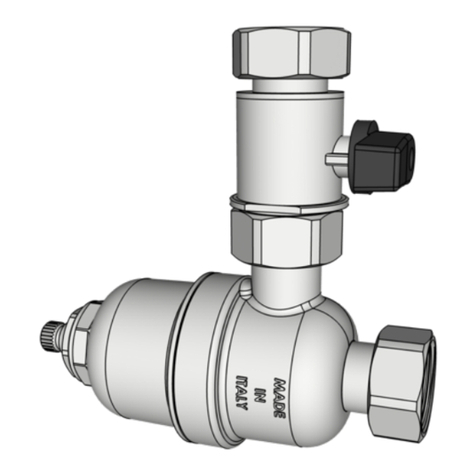
Ferroli
Ferroli MAGNETO 0YBE0AX0 Instruction and maintenance manual
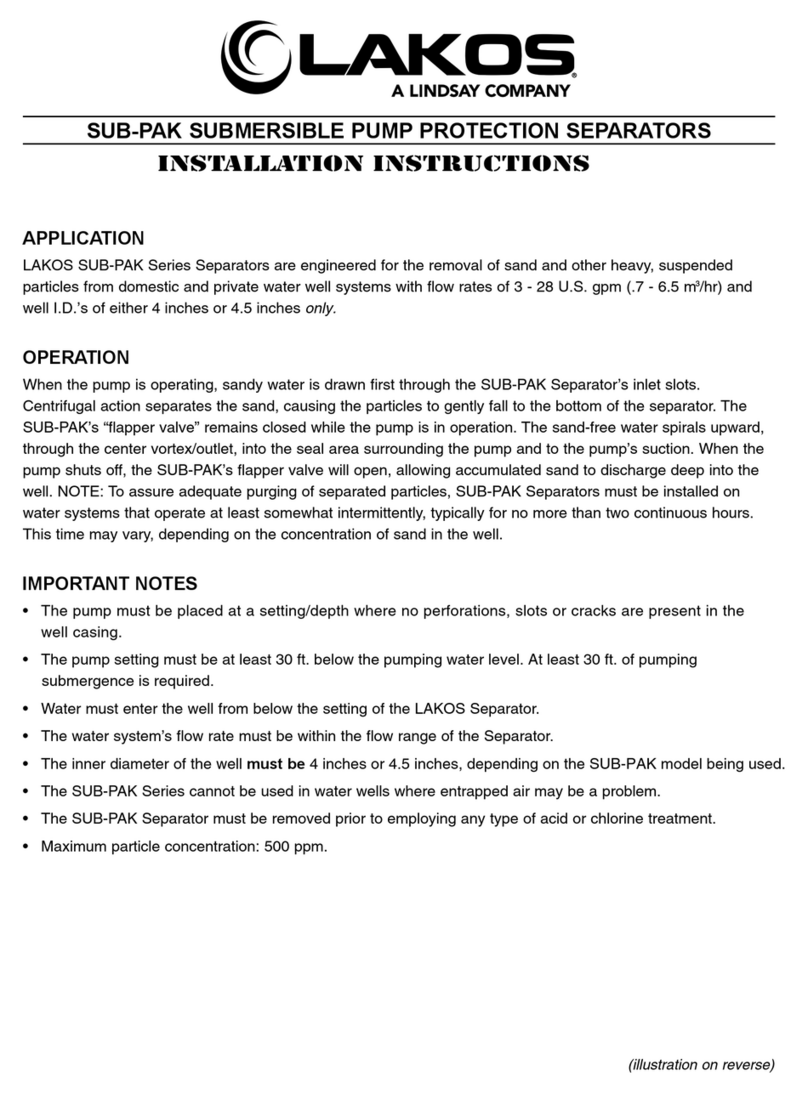
Lakos
Lakos SUB-PAK installation instructions
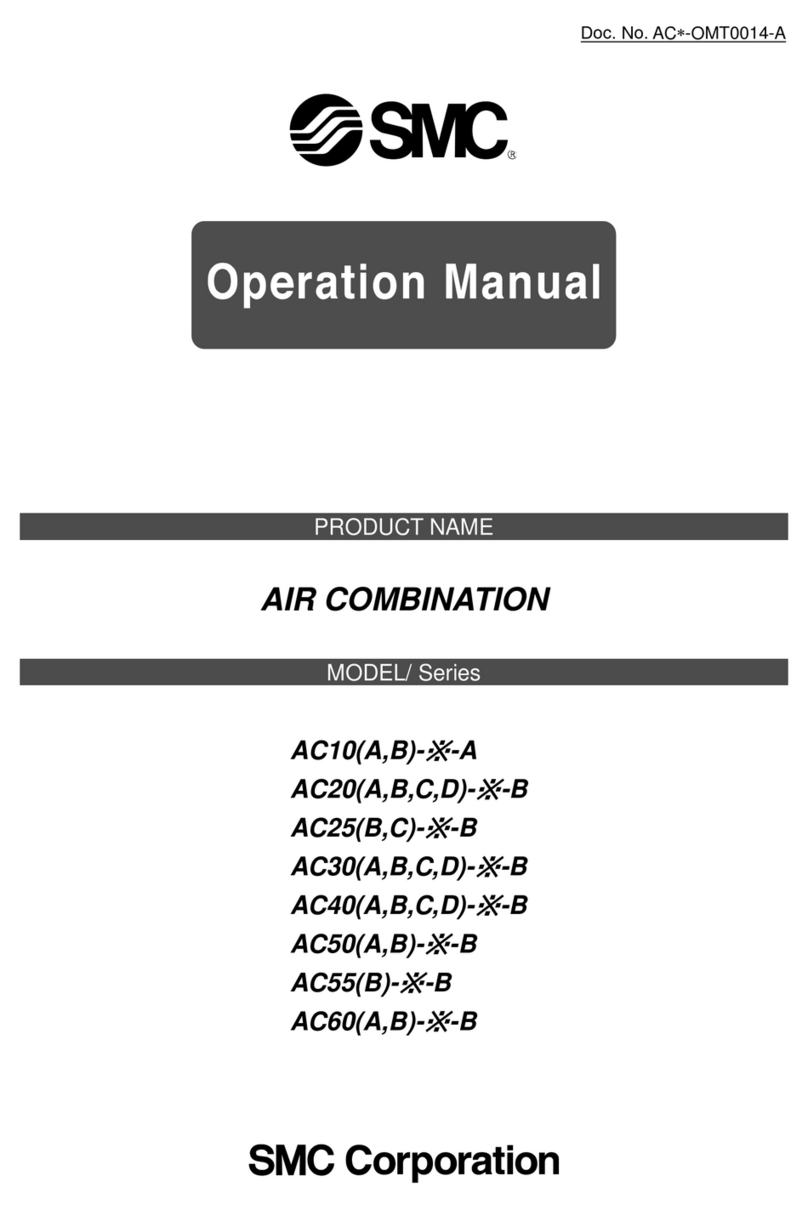
SMC Networks
SMC Networks AC10 A Series Operation manual
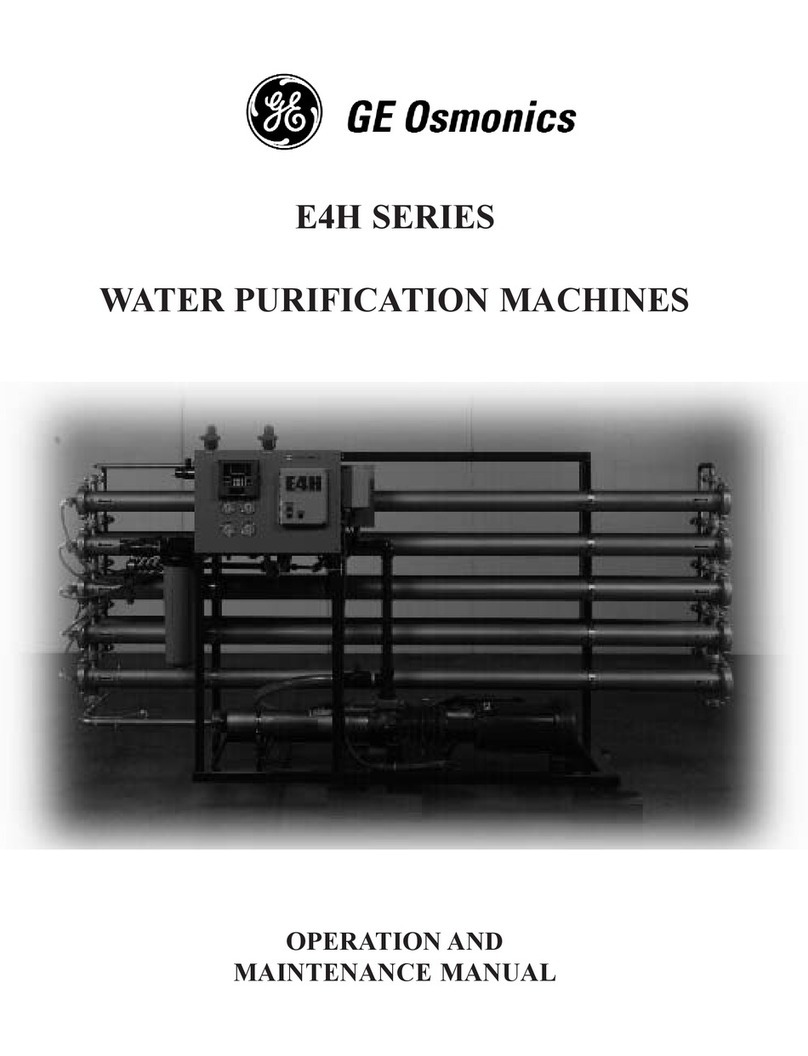
GE
GE Osmonics E4H Series Operation and maintenance manual

CPI
CPI Olympic SF119 owner's manual

Oase
Oase Aquarius Universal Classic operating instructions

US Water Systems
US Water Systems 300-H-4510-BG-222-KIT owner's manual
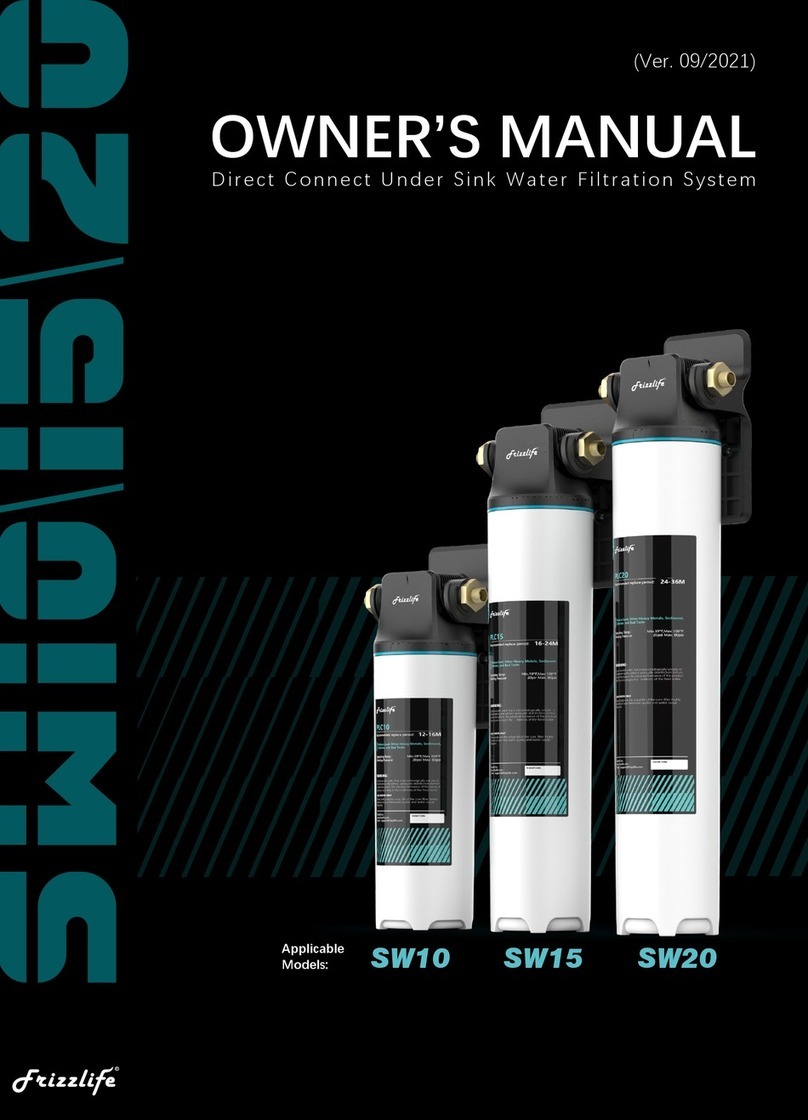
Frizzlife
Frizzlife SW10 owner's manual

Canature WaterGroup
Canature WaterGroup Aqua Flo AQUV-8R12 owner's manual

MSR
MSR SweetWater user manual

Aquadistri
Aquadistri SuperFish X-Pro Series user manual
